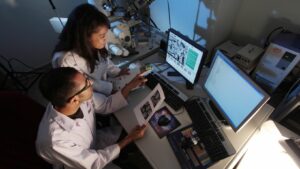In the shadowy realms of cyberpunk fiction, operating systems aren’t just tools; they’re gateways to vast digital landscapes of neon-lit data and shadowy cyberdeals. These fictional systems blend advanced technology with gritty aesthetics, offering a tantalizing glimpse into a world where information is the ultimate currency. As technology advances at a breakneck pace in the real world, the line between these sci-fi fantasies and reality begins to blur.
Cyberpunk operating systems, often depicted as the backbone of hacker culture and corporate espionage, embody the genre’s themes of high-tech and low-life. They serve as a critical element in storytelling, providing characters with the power to manipulate their dystopian worlds. Exploring these systems reveals not only the imaginative breadth of their creators but also echoes current concerns about privacy, security, and control in our increasingly digital society.
As we delve deeper into the characteristics and functionalities of cyberpunk operating systems, it’s clear they’re more than mere plot devices. They reflect our deepest fears and highest hopes about the future of technology.
Cyberpunk Operating Systems
Defining Cyberpunk in Technology
Cyberpunk in technology refers to the fusion of advanced technological and scientific achievements with a degree of breakdown or radical change in the social order. Cyberpunk environments typically showcase a society that is technologically saturated, yet fragmented or oppressed. Innovations such as artificial intelligence, hacking tools, and cybernetic enhancements are commonplace in these settings, foregrounding a future where technology suffuses every aspect of life. This term captures the essence of how technology permeates and influences dystopian futures, often highlighting the paradoxical relationship between human capability and technological dependency.
Characteristics of Cyberpunk Operating Systems
 Cyberpunk operating systems are distinguishable by several key features that align with the overarching themes of the genre. These systems often:
Cyberpunk operating systems are distinguishable by several key features that align with the overarching themes of the genre. These systems often:
- Promote Intricacy: They exhibit complex interfaces that mirror the complicated lives and fragmented societies depicted in cyberpunk narratives.
- Enable Connectivity: Users interact seamlessly with a range of networks and devices, suggesting a hyper-connected world.
- Emphasize Modification: Reflecting the genre’s focus on individualism and counter-culture, these operating systems are highly customizable.
- Prioritize Security and Anonymity: Given the dystopian contexts, these systems frequently enhance user privacy to safeguard against pervasive surveillance and control.
- Showcase Aesthetic: They often carry a distinct visual style that echoes the grim, neon-lit landscapes of cyberpunk worlds, employing dark themes with bright, contrasting elements.
Each feature is crafted to deepen the involvement in a world where technology’s influence on human life is profound and, often, troubling. These operating systems are not just functional; they are an integral part of the narrative, helping users navigate—and often challenge—the complex digital realms that define the cyberpunk ethos.
The History of Cyberpunk OS Development
Early Imaginations and Influences
 The origins of cyberpunk operating systems trace back to the genre’s literary roots, where authors envisioned a future dominated by advanced technology and corporate control. In the 1980s, cyberpunk literature, like William Gibson’s “Neuromancer,” introduced the concept of a digital landscape accessed through elaborate computing interfaces. These narratives often depicted society’s underbelly intertwined with high-tech realities, setting the thematic foundation for cyberpunk OS development.
The origins of cyberpunk operating systems trace back to the genre’s literary roots, where authors envisioned a future dominated by advanced technology and corporate control. In the 1980s, cyberpunk literature, like William Gibson’s “Neuromancer,” introduced the concept of a digital landscape accessed through elaborate computing interfaces. These narratives often depicted society’s underbelly intertwined with high-tech realities, setting the thematic foundation for cyberpunk OS development.
Artists and visionaries in visual media expanded these ideas, portraying operating systems with gritty aesthetics and unconventional functionalities. Films such as “Blade Runner” (1982) and “Ghost in the Shell” (1995) visualized interfaces that blend human cognition with machine intelligence, influencing both the visual and functional aspects of cyberpunk OS design.
Major Milestones and Innovations
 By charting specific advancements, one can observe how fictional concepts gradually influenced real-world technology. The early 2000s saw the emergence of skins and themes for operating systems that mimicked cyberpunk aesthetics, offering users a taste of life within a high-tech, dystopian scenario.
By charting specific advancements, one can observe how fictional concepts gradually influenced real-world technology. The early 2000s saw the emergence of skins and themes for operating systems that mimicked cyberpunk aesthetics, offering users a taste of life within a high-tech, dystopian scenario.
However, the mid-2010s marked a significant turn as developers began incorporating robust encryption methods and decentralized networks—both key traits envisioned in cyberpunk lore. Examples, such as the introduction of blockchain technology and the development of Linux distributions like “Qubes OS,” showcase systems built on principles of security and privacy, echoing the cyberpunk ethos of battling against overarching control.
Additionally, ongoing advancements in AR and VR interfaces are continuously reshaping how users interact with digital environments, bringing the cyberpunk vision closer to reality. These interfaces offer immersive experiences that were once purely speculative, demonstrating the genre’s lasting impact on the evolution of operating systems.

